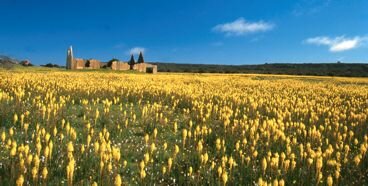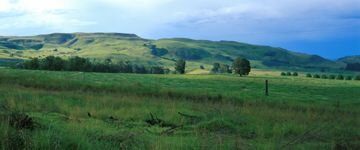Home
Study Sites
Research
Results
Publications
Links
Contacts
Conservation farming research sites
The Conservation Farming project focused on farms in South Africa that lie within four recognised areas of high biodiversity, where the reserve network is inadequate (less than 5% of the land area) and where farmers have experimented with alternative and apparently biodiversity-friendly farming practices. The areas we chose are:
- The Bokkeveld Plateau, especially the area around Nieuwoudtville, which straddles the boundary between two biodiversity hotspots, the Succulent Karoo and the Cape Floristic Kingdom.
- The Nama Karoo which covers an extensive area in the centre of South Africa.
- The Southern Drankensberg which forms part of the Eastern Mountain Centre of plant diversity.
- The Succulent Thicket in the Eastern Cape which falls within the Albany Centre of plant diversity.
click on the map if you would like to enlarge it.
Bokkeveld Plateau | Back to top |
The Bokkeveld Plateau is a semiarid region that straddles the margins of the Cape Floristic Region and the Succulent Karoo. Both the Cape Floristic Region and the Succulent Karoo are recognised biodiversity hotspots, and, unsurprisingly, the Bokkeveld Plateau has remarkably high plant diversity (ca. 1350 species) and endemism (6.5%).
The area of most interest for this study lies in the vicinity of Nieuwoudtville (31° 23'S 19° 07'E) and comprises ca. 300 km2 where there are parallel bands of soils derived from sandstone dwyka tillite and dolerite, each with their own characteristic vegetation. This area has been identified as containing critical and irreplaceable habitats for conservation. The area is particularly rich in geophytes, many of which are endemic, and is a key conservation area for bees and wasps. As such, it is a primary target for conservation action owing to the extremely high levels of species diversity, endemism, rarity and the high threat to remaining habitats.

Until the 1960's, wheat farming was the predominant landuse. Wheat farming left small pockets of natural vegetation between cultivated lands. This type of farming was sustained (at least in part) by farming subsidies at times of poor production but, with the elimination of subsidies over the past few years, it is questionable whether wheat production in the area is still sustainable.
An alternative approach to stockfarming has been practised on a farm in the area since the early 1960's and this farm is renowned in the area for the abundance of spring-flowering plants, especially geophytes. The management system uses both natural vegetation and rehabilitated croplands seeded with medicago to provide forage reserves. All farming practises are designed so that they do not disturb the soil profile containing the subterranean component of geophytic plants. The stock rotation system also takes into consideration the growing, flowering, and seeding times of geophytes. We studied the landuse and management practices on various farms in the Nieuwoudtville area. Land management practices include high intensity wheat farming, wheat farming supplemented by sheep production, and the use of natural vegetation only to sustain sheep.
Nama Karoo | Back to top |
The Nama Karoo, which occupies 607 235 km2, is the largest biome in South Africa. The entire biome is characterized by low (ca. 200 mm) and variable annual rainfall which results in grass and shrub biomass production that is highly variable in space and time. The area is only suitable for extensive livestock pastoralism but the frequency of disaster-magnitude droughts presents a huge challenge to farmers trying to make a sustainable living in this area. In precolonial times, the stochastic availability of food and water was partly overcome by nomadic farming practices. However, nomadism is no longer practical, and residential farming has resulted in veld degradation and loss of biodiversity over large areas. State-sponsored stock reduction schemes during droughts contributed to keeping farmers on the land and alleviated some of the impacts of stock on the vegetation. However, this policy has been discontinued.
On the farm Elandsfontein near Beaufort West (32° 17'S 22° 52'E), the farmers have devised and experimented with a system that allows for an accumulation of forage reserves and the optimal use of forage by stock. The 7000 ha farm uses multicamp infrastructure with a diversity of animals (boer goats, sheep and cattle).We compared data from Elandsfontein with data from two other farms with similar substrates and climate but where only sheep are farmed and where stocking practices currently recommended by the Department of Agriculture are applied.
Southern Drakensberg | Back to top |
The study in the Eastern Mountain Centre of plant diversity concentrated on the southern KwaZulu-Natal Drakensberg near Underberg (29° 46'S 29° 30'E). Much of the area has been used for extensive grazing of cattle or dairy farming on commercial farms or rough grazing on communal land areas. Grazing has been regarded as a biodiversity-friendly landuse although poor pasture management has resulted in sheet and gulley erosion and a loss of biodiversity. Harvesting of firewood and collection of medicinal plants is also common practice on communal land. Stock theft and recent changes in the economics of farming have resulted in a move towards alternative forms of landuse such as ecotourism, game farming, plantation forestry and high-yield crops (potatoes, maize).

We examined the ecological and economic aspects of three landuse types, i.e. stock farming (incl. dairy farming), crops and plantations. In the case of stock farming, we considered both communal and commercial farms.
Succulent Thicket | Back to top |
The Albany Centre of plant diversity is situated in the Eastern Cape province of South Africa. The Thicket Biome occurs in the western part of the Albany Centre and has high levels of endemism. Extensive pastoralism, mainly with angora goats, has been the predominant landuse but frequent droughts and poor stock management have resulted in degradation, erosion and loss of biodiversity. Several farmers have switched to game farming as an alternative to stock farming and this appears to be a more biodiversity-friendly and sustainable form of land use.
The study focused on eight paired farms in the vicinity of Kirkwood (33° 25'S 25° 25'E)(4 farms along the Groot Winterhoekberge), each pair comprised one farm with game and one with goats or other stock units. Some farms in the area are in transition from goat farming to game farming and this provided an additional aspect for investigation. The Addo Elephant National Park is adjacent to the farms that are included in the study and this provided a comparative baseline area for biodiversity studies.
These pages use CSS style sheets.
If you experience problems viewing them, please turn style sheet support in your browser off, or download a new browser.
|
Farmland occupies more than 80% of the land area of South Africa. So conservation farming can make a major contribution to nature conservation. |